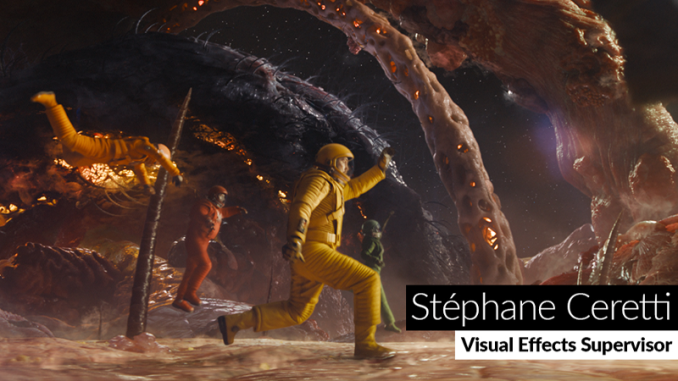
Director James Gunn brought a new level of emotional power to “Guardians of the Galaxy Vol. 3” by making the wisecracking Rocket (voiced by Bradley Cooper) and his tragic backstory the centerpiece of the finale. This required the Oscar-nominated VFX (led by Marvel’s production VFX supervisor Stéphane Ceretti) to up its game considerably to meet the demands of Gunn’s intimate scale and epic scope.
Framestore (led by VFX supervisor Alexis Wajsbrot) was tasked with expanding and improving its keyframe animation of Rocket through six stages, from genetically altered baby raccoon to hardened weapons expert. This allowed for greater nuance and complexity in the facial performance along with more detailed fur and an evolved gait and physiology. “It’s really a chain of artists that work together and get that to the level where other humans looking at it are crying because of a CG raccoon,” Ceretti told IndieWire in the video below. “And we shot all of this with Sean [Gunn physically playing Rocket]. We were shooting super closeups on his eyes… [and] the wetness in the eyes was to such a degree, [with] so much emotion coming out of it. And we were replicating the timing of his little blinks very precisely because we got so much out of the acting.”

But the way they approached Rocket’s origin story as the centerpiece of the High Evolutionary’s (Chukwudi Iwuji) cruel experimentation was unusual. It was a partial virtual production shoot, utilizing mo-cap not for the animation (which was still keyframed) but for more fluid and dynamic camera movement. Yet it was so important that they devoted the first two days of production to capturing the 15-minute flashback footage.
“James came to me, and he said, ‘How do I capture these sequences the way I would film the rest of the movie, knowing it’s four CG characters [Rocket, otter Lylla, walrus Teefs, and rabbit Floor]?’” added Ceretti. “So we looked at virtual production setups. I wanted to actually motion capture the camera moves. We set up a volume capture with some bars, which was allowing us to capture the coverage that James usually does on any other scene in the movie, so that we could replicate his shooting style. And that allowed us to get that shot very early in the film and get that beautiful emotion from the actors.”
Framestore also animated a redesigned Groot (voiced by Vin Diesel) as bulkier and more powerful. He’s human size, he can grow his arms, and he keeps expanding throughout the film. “We had like wood plates moving on top of each other trying to bring back a little bit of the vibe that we had on the first Groot in terms of the way his face was structured so it was a little less of a malleable shape,” Ceretti said. “It was fun to see how much action he had on this one, and when he’s transforming into that OctoGroot with his eight tentacles and working in tandem with Quill [Chris Pratt] and [Rocket on his shoulder].”
Meanwhile, Gunn’s desire for more ambitious action included leaning heavily into ’70s sci-fi comic books for the battle aboard the Orgoscope, the bioformed space station with trippy-looking pink plants made of meat and surfaces comprised of ugly surgical operations (courtesy of production designer Beth Mickle). Sony Pictures Imageworks (led by VFX supervisor Theo Bialek) did the VFX, which contained some very humorous, squishy fighting. “It was really hard getting the right balance between all the ingredients,” said Ceretti. “It needs to be a place that feels very tactile. That’s the last time we see the Guardians fighting together.”
Finally, the climactic battle with the High Evolutionary aboard the Arete spaceship was a two-minute, single-shot tour de force, with Wētā FX (led by VFX supervisor Guy Williams) handling the VFX. Shot at 120 frames per second — which allowed them to slow down the best action beats — the team stitched together 18 shots (roughly 12 minutes of footage) choreographed to “No Sleep Till Brooklyn” by Beastie Boys. “It was very, very complicated to shoot,” Ceretti said. “We had to give everybody a little bit of time, and we had to do it on the rhythm of the music, and we had to do it as a oner, and we had to be able to ramp up and down the speed of the camera. It’s a big mixture of digital double, digital environment, stunts, effects, and all of that timed to the music finding that right balance between the eye candy [and] the storytelling.”
SOURCE: IndieWire

